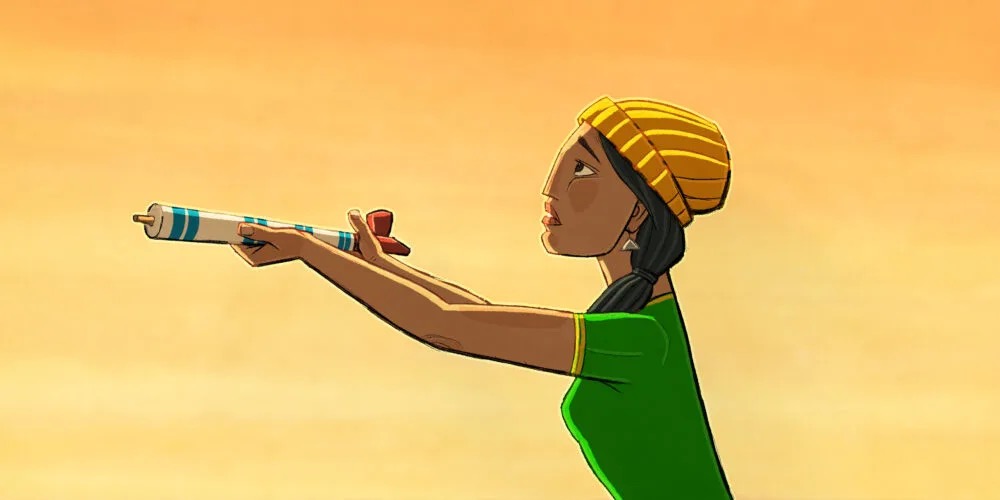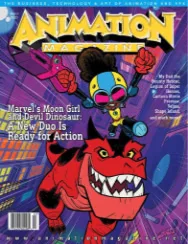|
Getting your Trinity Audio player ready...
|
The upcoming Hungarian animated feature Four Souls of Coyote is one of the highly original and anticipated features debuting at Cartoon Movie this month. Produced by Budapest-based Cinemon Entertainment and written and created by Annecy Cristal winner Áron Gauder (The District), the 2D-animated project is described as an epic adventure about the creation of the universe inspired by a Native American myth.
“I have always been inspired by Native American culture since my childhood days,” says Gauder in an exclusive Animation Magazine interview. I made two short animated shorts films based on Native American tales with a similar visual approach. During the Communist era, I participated in Native summer camps and acquired some knowledge about the harmony between humans and the Earth.”

Inspired by Myths and Songs
A big turning point for Gauder was meeting Tamás Cseh, a legendary Hungarian songwriter and the founder of the Hungarian American Indian cultural circle. “When I discovered about six years ago that he had translated Native American folktales and recorded them before he died, I couldn’t stop thinking about bringing these stories to life through animation,” he tells us.

The songwriter had recorded eight tales for an album. As Gauder recalls, “The real journey of the film began when I discovered these records and approached Cinemon Entertainment producer Réka Temple with the idea of co-producing an adaptation of the records as an animated series. I think that just reading and hearing about his stories, I could see how it would make a beautiful and thoughtful film. We made two episodes of the Coyote Tales, which have achieved significant international festival successes. After making the shorts, I felt that there was still plenty to tell and the visuals look good on wide screen. That’s how the idea of the feature story came.”

Temple, who has produced such well-received projects such as Coyote and the Rock, Willy and the Guardians of the Lake and Volutes des Anges, says, “Making Four Souls of Coyote and the first two short films has taken 10 years of my life!” she notes. “The movie has been a special experience during challenging times. There were many pitches and trips during the first couple of years. Then, finally, when we got the greenlight for production, COVID hit. We needed to build a safe working space (mostly online at the beginning) to be in the mood for such an artistic and meaningful project.”
Pre-production for the film began in 2016, the production commenced in early 2020, and post-production work was completed in January. Gauder says, “The film was produced in Hungary at Cinemon Entertainment studios along with 180-200 artists, some working from abroad. The English cast includes Native American actors and was produced by Verité Entertainment in the U.S.A. and Canada.”
The English voice-cast is led by Lorne Cardinal Stewart (Creator), Diontae Black (Coyote), Danny Kramer (Man), Stephanie Novak (Woman) as the main characters. Further roles include Charlie Carroccio, Summer Simpson, Ira Heiden, Bennett Osbrink, Bob Klein, John Bentley, Frank Todaro, Eric Morgan Stewart, Emily Stockdale, Michael Pizzuto and Priscilla Landham.
The film features themes from Native American female artists including Ulali, Mariee Siou, Joanne Shenandoah and The Sessions Voices, they all play in a lot of different ways incorporating the mood changes of the film.
The director of Four Souls of Coyote conceived and drew all the visuals and the characters based on his imagination. “The characters and background are always hand painted,” he says. “The film combines 2D and 3D; 3D only serves the camera movement in the background in so-called projection. In order to keep this idea throughout the process, we worked a lot with the animation director, Zsolt Baumgartner. The entire film is actually enriched by the help and instruction of all the animators.”
The film’s visuals are a fascinating mix of real-world influences and the world of visions and dreams. “We integrated and imitated different optics, lenses, camera effects and lighting using various experiences,” says Gauder. “The story of creation is told in the visual construction of the film. In the beginning there are no colors, only paper. Step by step, lightly painted watercolors appear in shades of blue water and gray skies. As the creator lifts up the sky, the light appears, introducing a new graphic element. With a combination of 2D and 3D, two graphic worlds are combined.”

Gauder mentions that the movie’s characters were initially quite stylized, but eventually the animation became more realistic. “The more stylized solutions, consisting of specifically [Native] motifs, appear primarily in dream scenes and on the clothes and decorations of the characters,” he says. He also says he has been inspired by a wide range of features, including Hungarian director Marcell Jankovics’ Son of the White Mare, Hayao Miyazaki’s Princess Mononoke and Spirited Away, Cartoon Saloon’s Song of the Sea and Wolfwalkers.
Striving for authenticity, the director immersed himself in original Native American cultures and history while seeking advice and feedback from experts in the field. “I have always been interested in this culture because I have been fascinated by their history and genuine experiences,” he says. “When I met Tamás Cseh, 27 years ago, he shared materials about American Indian culture which captivated me. I also read Karl May’s books, watched Gojko Mitić’s films, and learned about the ancient Native American experiences and their stories. I also attended a Sun Dance indigenous ceremony, and I understood how close the tribe was to nature, clean and simple.”
Several well-known Native American experts, including Navajo anthropologist Charles Cambridge and Cheyenne-Arapaho director Chris Eyre, also participated as consultants on the project. “Members of the Cheyenne and Arapaho Tribes provided me with helpful information about projects against building the Dakota Access Pipeline and also connected with us with Native musicians,” says the director. “In several cases, the perspective of the indigenous people is much more modern than ‘more advanced’ Western thinking. Global warming and the rapid destruction of the environment cause common problems. Thousands of documentaries have been produced about this theme, and a great number of scientists have proven the very facts Native Americans have been talking about for centuries.”

Braving the Challenges
Temple mentions that the production faced many challenges over the past few years. “Last year we were hit by the war in our neighborhood, which fortunately had no direct connection to the production itself,” she says. “Still, we strongly sympathized with what is happening around us and around the world. We tried to find the harmony, which this film is all about. I truly believe that beside the strong visuals Áron has created we can also pass on the feeling of how important and joyful this film was for all of us producing it.”
She adds, “We have a saying in Hungarian that one of my eyes is smiling because the film has come to an end and that we managed to complete it in time. But, my other eye is crying because the film came to an end and we’re not in production on a daily basis anymore. Now, I am looking forward to seeing how the film resonates with the public all around the globe.”
“Four Souls of Coyote is an alternative and more modest creation myth, in which the human being is neither the top creature of nature nor the king of the world, but only one of all the creatures,” concludes Gauder. “With the help of animation, I would like to draw the attention to this story in an adventurous way and to point out that we should live environmentally responsible lives and respect Mother Nature. I believe that the story gives everyone hope that it’s still not too late to correct the current course. This is our final chance to save our planet.”
Four Souls of Coyote will premiere at Cartoon Movie and in Hungarian theaters in March.
Here is the brand-new English-Language trailer:













